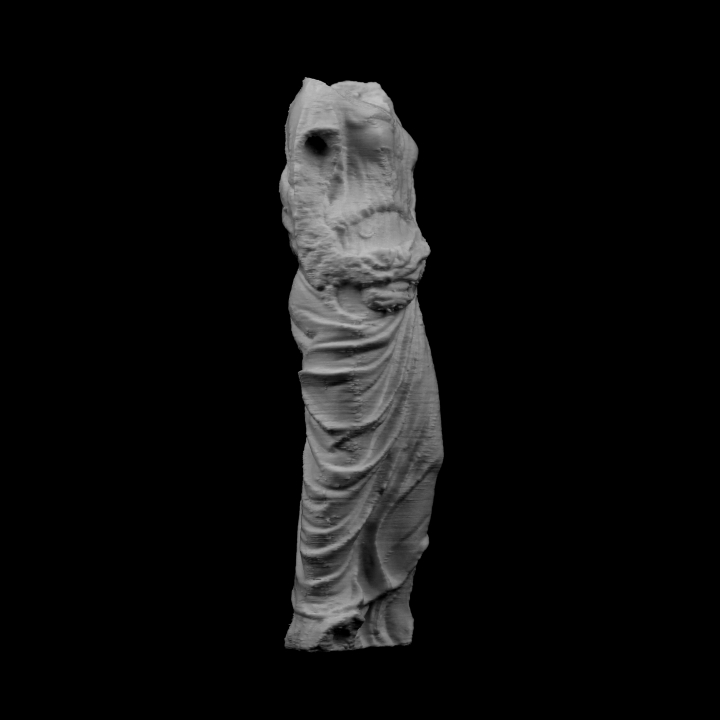
Aphrodite Doria-Pamphili at The Louvre, Paris
myminifactory
This breathtaking sculpture of Aphrodite is one of the most exquisite replicas of a timeless masterpiece from the last years of the 5th century BC. This style of statue owes its name to the most magnificent surviving example, now proudly displayed in the Doria Pamphili Palace in Rome. The question of the original creator's identity remains an intriguing mystery. Some experts firmly believe that this work is a replica of Aphrodite Urania by Phidias, while others passionately argue that it is a creation of his contemporary Agorakritos of Paros. A stunning marble masterpiece from ancient Greece In 1996, the Louvre Museum acquired a remarkable marble sculpture that formerly stood in the gardens of Ombreval, the estate of Stéphane Dervillé in Domont, Val d'Oise, near Paris. This magnificent work was crafted using the acrolithic technique, where the extremities - the head, right shoulder, arms, and feet - were sculpted separately and added later, although the entire piece is made from marble. This enchanting effigy of Aphrodite is one of a series of replicas of an ancient Greek masterpiece dating back to the classical era - more specifically, the final decades of the 5th century BC. The most complete example, now housed in the Doria-Pamphili Palace in Rome, has given its name to this style of statue in general. Inspired by Polykleitos' iconic works The contrapposto position, invented by the renowned classical sculptor Polykleitos in the mid-5th century BC, is a defining characteristic of this style. This asymmetrical pose features the shoulders turned in the opposite direction to the hips and one leg slightly forward, with the weight of the body on the other leg. Unraveling the mystery of the creator's identity The debate surrounding the sculptor's identity has sparked intense discussion among art historians and enthusiasts. The treatment of the drapery and the nude shoulder, a motif often used by sculptors to convey the sensuality of the goddess of love, seems to link this Aphrodite to the semi-reclining Aphrodite on the eastern pediment of the Parthenon. Some experts attribute the original work to Phidias, who directed the architectural decor of the Parthenon between 447 and 432 BC. In this case, the original is identified as either the Aphrodite Urania (the Heavenly Aphrodite) in Elis or the Aphrodite on the Agora in Athens. However, this attribution raises several challenges. Some effects of the drapery exceed the aesthetic canon of the Parthenon and are more akin to works from the end of the 5th century BC. Furthermore, none of the Doria-Pamphili-style replicas includes the tortoise on which the Aphrodite Urania in Elis was resting a foot. Therefore, it is more likely that this sculpture is the work of Agorakritos of Paros, a student of Phidias who also worked on the Parthenon. He probably completed this statue around 420 BC. The stylistic similarities between this replica and what we know of Agorakritos' major work, the Nemesis of Rhamnus, seem to confirm this hypothesis. A masterful rendering of mannerist style The sculptor responsible for the Aphrodite now in the Louvre has skillfully captured the richness and diversity of the folds of the goddess's garment, carving the marble in a style characteristic of sculptors working in the late 5th century BC. The goddess is wearing a thin, short-sleeved tunic known as a chiton and a mantle of thicker fabric called a himation. The wind is playing with the cloth of her garments, molding it to the goddess's body in some places and filling it out in others. The artist has successfully imitated the mannerist effects of the drapes, which seem to twist and writhe in some areas, while elsewhere they mimic the wet cloth effect, clinging revealingly to the nude body of the goddess. Her feminine attributes are evident beneath the thin material. This object is part of "Scan The World," a non-profit initiative introduced by MyMiniFactory. Scan the World aims to create a digital archive of fully 3D printable sculptures, artworks, and landmarks from across the globe for public access free of charge. Scan the World is an open-source community effort. If you have interesting items around you and would like to contribute, email stw@myminifactory.com to find out how you can help.
With this file you will be able to print Aphrodite Doria-Pamphili at The Louvre, Paris with your 3D printer. Click on the button and save the file on your computer to work, edit or customize your design. You can also find more 3D designs for printers on Aphrodite Doria-Pamphili at The Louvre, Paris.
